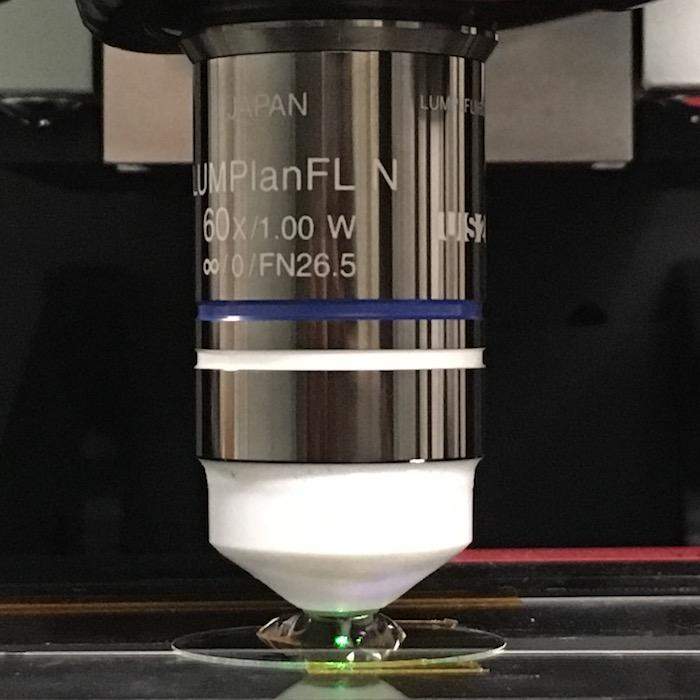First flat lens for immersion microscope provides alternative to centuries-old technique

Harvard researchers integrated an immersion meta-lens into a commercial scanning confocal microscope, achieving an imaging spatial resolution of approximately 200 nm. Image courtesy of the Capasso Lab/Harvard SEAS
A team of researchers from the Harvard John A. Paulson School of Engineering and Applied Sciences (SEAS) has developed the first flat lens for immersion microscopy. This lens, which can be designed for any liquid, may provide a cost-effective and easy-to-manufacture alternative to the expensive, centuries-old technique of hand polishing lenses for immersion objectives.
The research is described in Nano Letters.
“This new lens has the potential to overcome the drawbacks and challenges of lens-polishing techniques that have been used for centuries,” said Federico Capasso, the Robert L. Wallace Professor of Applied Physics and Vinton Hayes Senior Research Fellow in Electrical Engineering at SEAS, and senior author of the paper.
When light hits an object, it scatters. Optical microscopes work by collecting that scattered light through a series of lenses and reconstructing it into an image. However, the fine detailed geometrical information of an object is carried by the portion of scattered light propagating with angles too large to be collected. Immersing the object in a liquid reduces the angles and allows for the capturing of light that was previously impossible, improving the resolving power of the microscope.
Based on this principle, immersion microscopes use a layer of liquid — usually water or oil — between the specimen slide and the objective lens. These liquids have higher refractive indices compared to free space so the spatial resolution is increased by a factor equal to the refractive index of the liquid used.
Immersion microscopes, like all microscopes, are comprised of a series of cascading lenses. The first, known as the front lens, is the smallest and most important component. Only a few millimeters in size, these semicircular lenses look like perfectly preserved rain drops.
Because of their distinctive shape, most front lenses of high-end microscopes produced today are hand polished. This process, not surprisingly, is expensive and time-consuming and produces lenses that only work within a few specific refractive indices of immersion liquids. So, if one specimen is under blood and another underwater, you would need to hand-craft two different lenses.
To simplify and speed-up this process, SEAS researchers used nanotechnology to design a front planar lens that can be easily tailored and manufactured for different liquids with different refractive indices. The lens is made up of an array of titanium dioxide nanofins and fabricated using a single-step lithographic process.
“These lenses are made using a single layer of lithography, a technique widely used in industry,” said Wei Ting Chen, first author of the paper and postdoctoral fellow at SEAS. “They can be mass-produced with existing foundry technology or nanoimprinting for cost-effective high-end immersion optics.”
Using this process, the team designed metalenses that can not only be tailored for any immersion liquid but also for multiple layers of different refractive indices. This is especially important for imaging biological material, such as skin.
“Our immersion meta-lens can take into account the refractive indices of epidermis and dermis to focus light on the tissue under human skin without any additional design or fabrication complexity,” said Alexander Zhu, coauthor of the paper and graduate student at SEAS.
“We foresee that immersion metalenses will find many uses not only in biological imaging but will enable entirely new applications and eventually outperform conventional lenses in existing markets,” said Capasso.
Media Contact
All latest news from the category: Power and Electrical Engineering
This topic covers issues related to energy generation, conversion, transportation and consumption and how the industry is addressing the challenge of energy efficiency in general.
innovations-report provides in-depth and informative reports and articles on subjects ranging from wind energy, fuel cell technology, solar energy, geothermal energy, petroleum, gas, nuclear engineering, alternative energy and energy efficiency to fusion, hydrogen and superconductor technologies.
Newest articles

NASA: Mystery of life’s handedness deepens
The mystery of why life uses molecules with specific orientations has deepened with a NASA-funded discovery that RNA — a key molecule thought to have potentially held the instructions for…

What are the effects of historic lithium mining on water quality?
Study reveals low levels of common contaminants but high levels of other elements in waters associated with an abandoned lithium mine. Lithium ore and mining waste from a historic lithium…

Quantum-inspired design boosts efficiency of heat-to-electricity conversion
Rice engineers take unconventional route to improving thermophotovoltaic systems. Researchers at Rice University have found a new way to improve a key element of thermophotovoltaic (TPV) systems, which convert heat…



